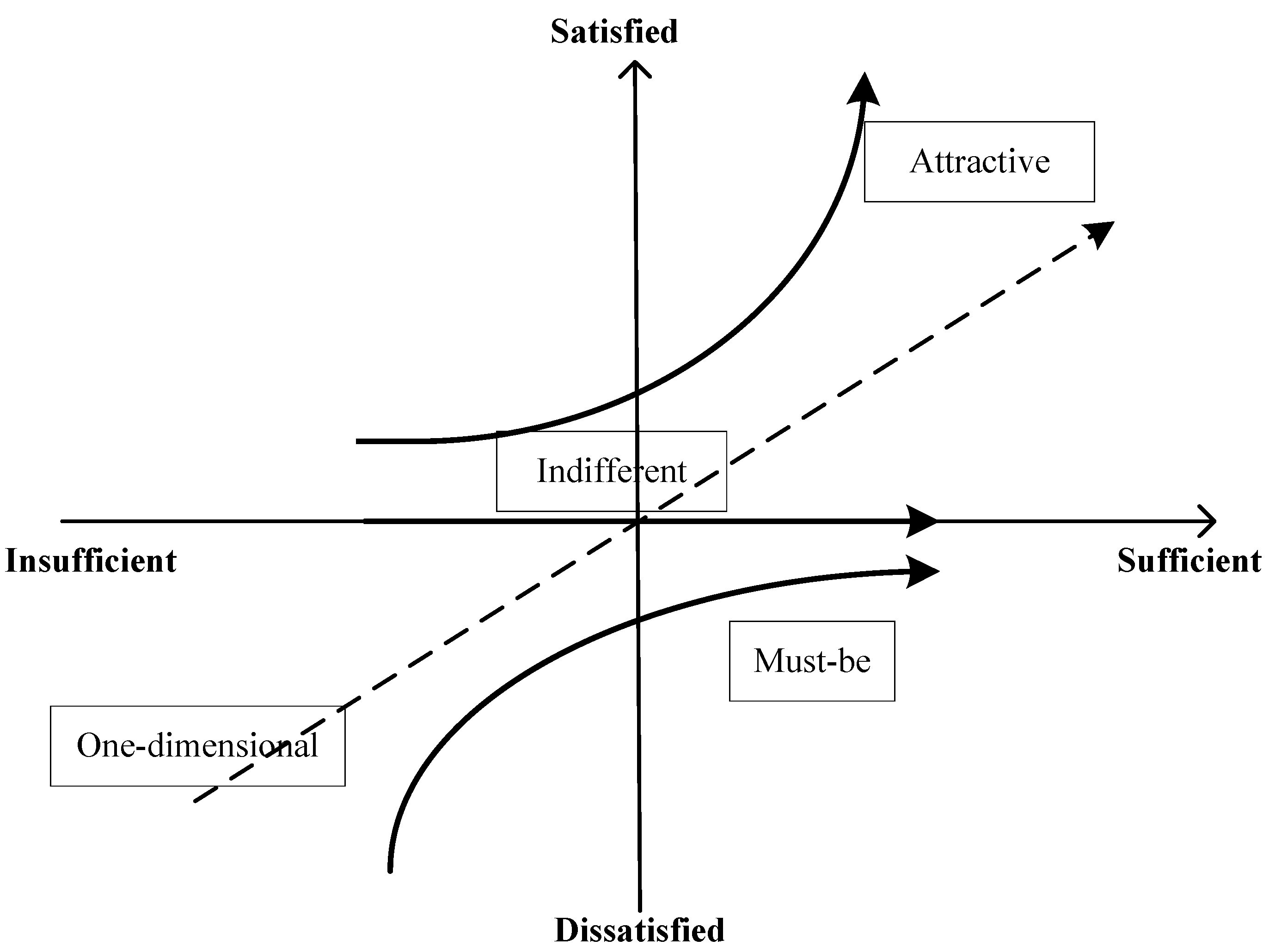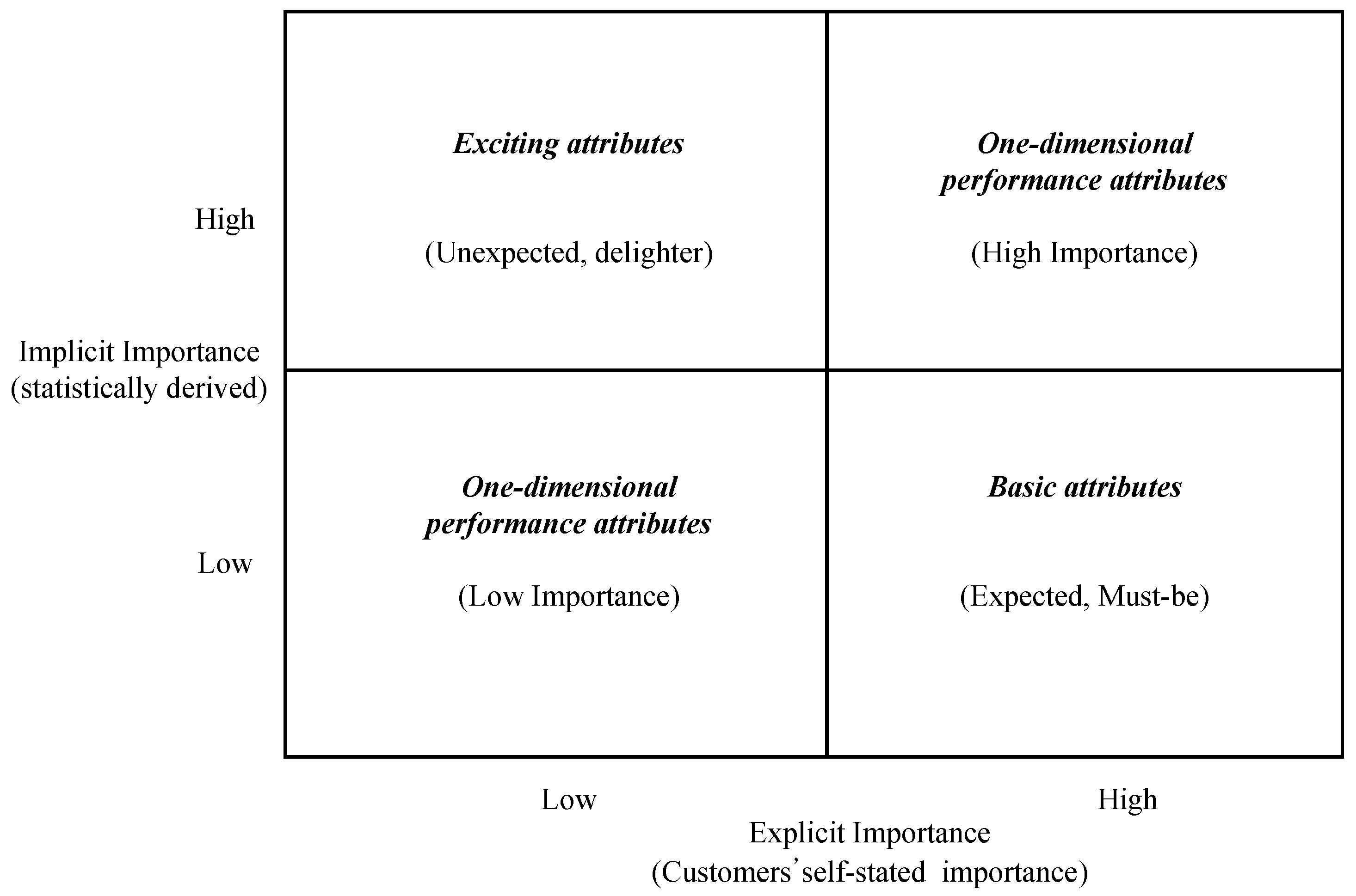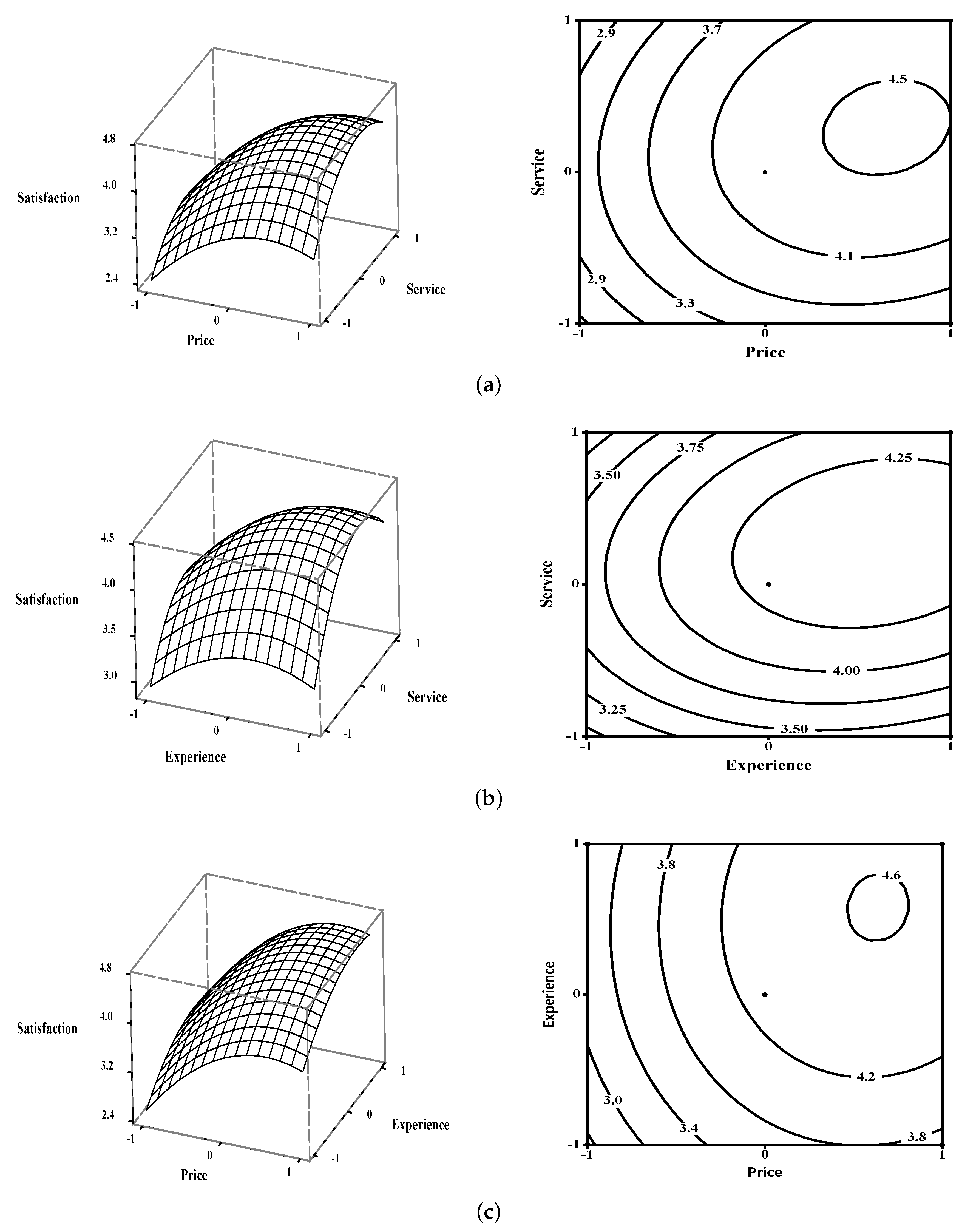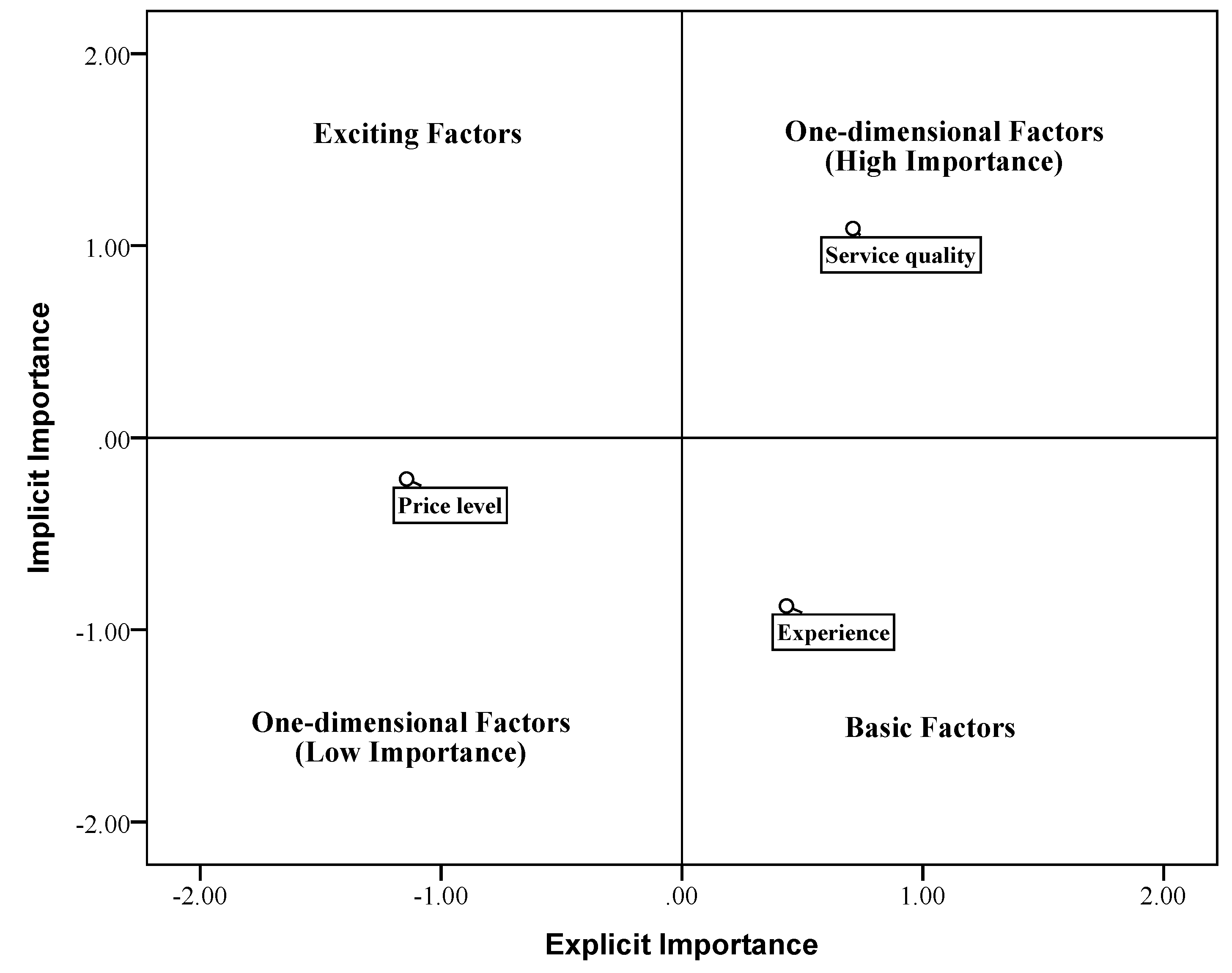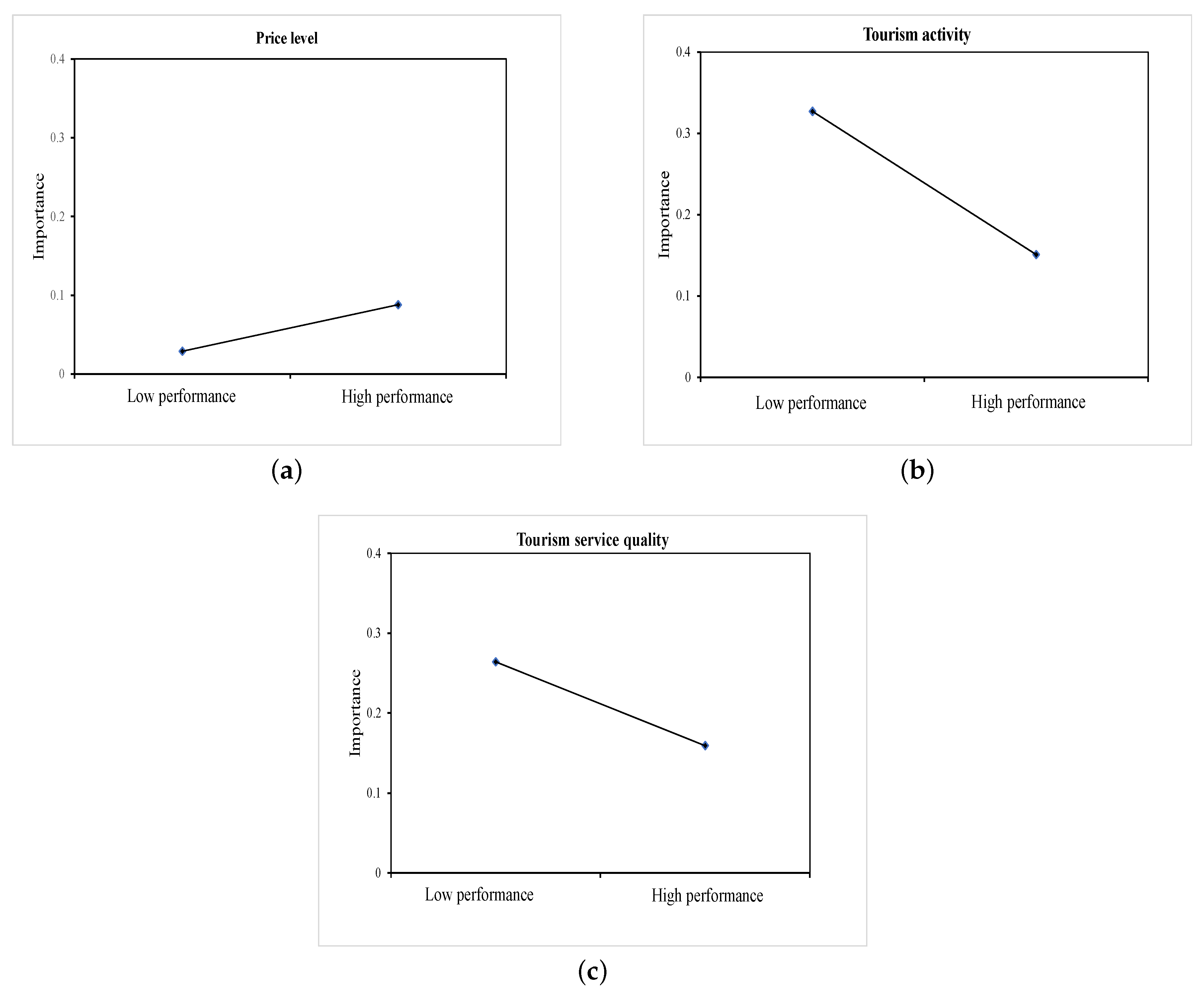2.1. Attribute Performance and Customer Satisfaction
Product or service attributes usually include features, functions, benefits, and uses, which are the characteristics by which offerings are identified or differentiated [
26]. Lancaster indicated that customers’ preferences were not on the product itself but on its characteristics or attributes [
27]. Therefore, customers are more likely to evaluate satisfaction at an attribute-level rather than product level [
28]. Furthermore, researchers pointed out that satisfaction is a function of performance on products or attributes, and it can be increased through measuring and managing performance ratings on these drivers [
11,
13,
29]. For these reasons, attribute-level approach is thought to be a better understanding of overall customer satisfaction [
16]. Based on that, other researchers suggested that customer satisfaction should be evaluated on a multi-attribute scale [
30].
Although the multi-attribute approach has implications for analyzing customer choice and decision making, several problems arise when measuring satisfaction. First, this approach fails to distinguish the customer’s experience or evaluation on attributes of positive and negative performance [
13]. In 2010, in Oliver’s research, when product performance is worse than expect or standard, negative discrepancy exists. Conversely, positive discrepancy will exist when performance is better than standard. Other researchers also stated that positive or negative of attribute performance has different impact on overall customer satisfaction [
13,
31]. The other limitation of this approach is that it treats the relationship between attribute performance and overall satisfaction as symmetric and linear. Under the linear relationship assumption, attributes with high performance will lead to satisfaction, and low performance will cause dissatisfaction. Yet, many studies have shown that the symmetric relationship has not always held true [
32,
33]. Mittal, in 1998, demonstrated that positive and negative performance on an attribute has different impacts on overall satisfaction based on prospect theory. As shown in
Figure 1, negative performance on attributes has a greater impact on overall satisfaction than does positive performance [
13].
Over the past decades, many studies have been carried out for investigating the asymmetric relationship between attribute performance and satisfaction. Since being proposed in 1984, the Kano model has been the most popularly implemented method in research on nonlinear relationship between attribute performance and satisfaction. This model was named “attractive quality creation” (AQC) by Kano, which means “creating a new product with a quality that cannot only be distinguished from the qualities of the current products but also is attractive for customers” [
34]. Based on a two-dimensional recognition, the physical sufficiency of the product or service is taken along the horizontal axis with “insufficient” and “sufficient” levels, and the customer’s perception with “satisfied”, “neutral” and “dissatisfied” levels is taken along the vertical axis (
Figure 2). To enable the measurement to be understood more easily, other studies described the horizontal axis as “expectations” (not fulfilled to exceeded), and the vertical axis is expressed as “customer delight” (low to high).
Based on quality’s evaluation patterns, four qualities can be acquired, including attractive quality, one-dimensional quality, must-be quality, and indifferent quality. The first three qualities are the most commonly used in the research, which are also described as three satisfaction factors including excitement factor, performance factor and basic factor. Kano model is thus referred to as three-factor theory. Basic factor (must-be quality) can respond to the basic needs for the product or service. This factor will cause dissatisfaction if not fulfilled, but do not bring customer delight if exceeded. On the contrary, excitement factor (attractive quality) can increase customer satisfaction if delivered but do not cause dissatisfaction if not fulfilled [
35]. Performance factor (one-dimensional quality) will lead to satisfaction on the high-performance attributes, and dissatisfaction on the low performance.
Regarding development of research theme in the Kano model, Witell, in 2013, stated the emergence and development phases of it. Classification of attributes and combination of Kano methodology with other methods are the research themes dominate according to the research results [
36]. In other studies, techniques or methods used in the Kano model were also the research focus [
16,
24,
37,
38]. For example, Mikulić, in 2011, compared four techniques with Kano method from the perspectives of validity and reliability [
38]. The Kano model is reasonable with the assumption that product or service attributes have a varying impact on overall customer satisfaction depending on their current level of performance [
37]. Although it has been empirically justified in several studies, the agreement was not established on assessment method of quality elements. For this reason, various modified or new approaches have emerged in recent years based on different research backgrounds and objectives.
2.2. Importance Grid Analysis
Vavra, in 1997, firstly proposed that importance grid can be used to identify the three satisfaction factors [
39]. Alternative to the imaginary scheme given by Kano, importance grid is constructed depending on whether the importance of attribute is derived explicitly or implicitly. Customer’s self-stated importance is identified as explicit importance, which is the indicator of an attribute’s dissatisfaction-generating potential. As an indicator of satisfaction-generating potential, implicit importance is obtained indirectly by applying other techniques such as regressing attribute-level performance against overall satisfaction [
12,
38,
40].
The assumption of importance grid analysis is that explicit importance and implicit importance might differ on reflecting the attribute’s importance–satisfaction relationship. Also, it is stated that the customer’s self-stated importance cannot measure the relative importance of attribute adequately [
41]. Importance grid analysis combines attribute importance weights derived explicitly and implicitly in a two-dimensional grid, and the attribute can be plotted according to the differences in importance weights (
Figure 3).
In terms of importance grid analysis, basic attributes are the factors which have the strong negative impact on overall satisfaction in low-level performance, but do not have a significant positive impact for high-level performance. As the minimum requirements of product or service can thus be identified as high importance in directly derived evaluation of attributes, but low importance in indirectly derived evaluation. Different from the basic attributes, exciting attributes are identified as not much important in directly derived evaluation but high importance in indirectly derived evaluation for its positive relationship with overall satisfaction on the high performance of attribute. For the one-dimensional performance attributes, the corresponding changes can be shown between the performance of attribute and overall satisfaction. It means that the attributes with high explicit and implicit importance can be explained as high importance attributes, and contrary to it, low importance attributes show the little importance both in explicit and implicit ways.
Based on the Kano model, we will use the response surface method and importance grid analysis to derive the relative importance of the attributes and classify the quality factors. In the process of response surface analysis, Box–Behnken design will be applied in profile design for reflecting consumer’s real attitude on the attributes. Therefore, this integrated approach can express the nonlinear relationship between attribute performance and satisfaction. Furthermore, it can also avoid the shortcoming existed in the regression analysis which excludes the information associated with average (common) level of performance [
24].

